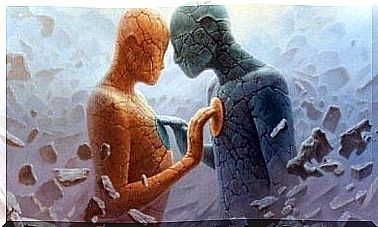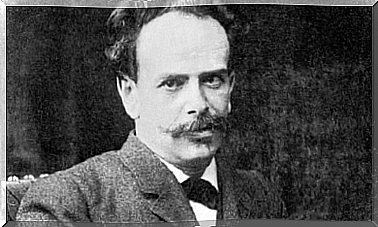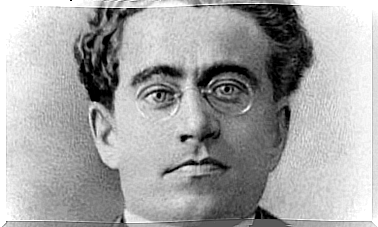Most Common Types Of Delirium

Delirium generally occurs in the context of a mental or neurological illness. However, it is of particular importance in the diagnosis of psychotic disorders. Psychiatrist and philosopher Karl Jaspers was the first to define the criteria for the types of delusion in his book General Psychopathology , published in 1913. In this article we will talk about it in detail, revealing differences and similarities.
Before being able to arrive at a real differentiation of the most important types of delirium , Jaspers indicated 3 fundamental criteria to be able to recognize these mental states. The scholar believed that the patient’s “judgments” or “beliefs” should be manifested with extreme conviction. Second, they could in no way be changed, not even by using other beliefs. Finally, he attached importance to the level of self-delusion or, conversely, an inability to believe that content. As you can see, importance was also given to the degree of reliability (or falsity) of the alleged patient.
Currently, a distinction is made mainly between two types of delirium depending on the form and content. Let’s try to deepen this interesting topic in detail.
Types of delirium: classification according to the form
From a formal point of view, there are two types of delusion:
- Primary (or real) delusion.
- Secondary delirium.
The primary delusion is characterized by autonomous delusional ideas, original, non-derivable and incomprehensible from a psychological point of view. They appear suddenly, with complete conviction and without other mental alterations that could favor their appearance.
In the secondary one, we talk about deliroid ideas, which derive from a previous anomalous experience. It is a delusional idea that arises as an attempt to explain something that the patient has experienced, but which he cannot explain in a rational way. In this sense, they are psychologically understandable.
The distinction between delusional and deliroids lies in the comprehensibility or otherwise of the delusion. This difference also implies an attempt to explain their respective origins. To say that secondary delusions are psychologically understandable alludes to the patient’s attempt to explain an abnormal experience.

Jaspers proposes 4 types of primary delirium
- Delusional intuition : primary delusional idea, from the phenomenological point of view indistinguishable from any other that suddenly attacks a person. The content of these delusions is usually self-referential and of great importance to the patient.
- Delusional perception : primary delusional idea consisting in the delusional interpretation of a normal perception.
- Delusional Atmosphere : Primary delusional idea consisting of the subjective experience that the world has changed in an imperceptible, but sinister, disturbing, difficult or impossible way to define. It is usually accompanied by an altered mood, as the patient feels uncomfortable, restless and even perplexed.
- Delusional memories : primary illusion that involves the delusional reconstruction of a real memory. Other times the patient “remembers” something that is clearly out of reality.
Types of delirium: classification according to their content
Psychoanalytic theories emphasized the symbolic importance of the content of the delusions. Some authors argue that the content of delusions is linked in particular to personal fears, aspects of life experiences and cultural factors.
However, some people argue that delusions are “empty” speech acts. Peruvian psychiatrist Germán Elías Berríos claims that their content is nothing more than a random fragment of information, trapped as the delusion crystallizes.
Despite this opinion, delusions have been studied primarily from the point of view of judgment and beliefs. And from this point of view, the content has a clear importance as a carrier of personal and cultural influences.
While the structure of delusions varies very little in different cultures, their content seems to be much more influenced by the cultural framework in which the delusional subject lives.
More frequent delusions by shape
- Delusional idea of jealousy : delusional belief that the partner is unfaithful. The beginning is sudden and brutal, the proof of the partner’s infidelity will depend on a gesture or a word. The subject will look for irrefutable evidence (search for objects, interminable interrogations, etc.).
- Illusory idea of grandeur : its content implies an exaggerated assessment of importance, power, knowledge or personal identity. It can be religious, aesthetic or other.
- Illusory idea of poverty : idea that the subject has lost or will lose all or almost all of his material possessions.
- Extravagant delusional idea : false belief whose content is clearly absurd and without a real possible basis. For example: a person believes that when she was operated on for appendicitis, a device was attached to her with which she can hear the president’s voice.
- Delusional nihilistic idea: idea of the non-existence of the self, of others and of the world. For example: the world is all a staging.

Most frequent delusions by content
- Delusional idea of being controlled : delusional idea in which feelings, impulses, thoughts or acts are experienced as if they are not one’s own and have been imposed by some external force. Typical delusions involve hypotheses about the alignment, theft or transmission of one’s thought.
- Erotomaniac delusional idea : the patient believes that someone else is madly in love with him. It affects women more than men. The person is convinced that he is loved by a person considered prestigious (movie star, politician, etc.).
- Somatic delusional idea : the person is convinced that they have a physical imperfection or an often incurable pathology. It can be difficult to distinguish this delusional disorder from hypochondria and body dysmorphic disorder. What distinguishes them is the intensity of the conviction. In delusional disorder, the person will never admit the possibility that the illness or physical defect could be unreal.
- Delusional idea of reference : delusional idea that events or people close to the subject’s environment have a particular sense of a generally negative type. If the delusional idea of reference is articulated in a persecutory theme, then one can also speak of a delusion of persecution.









